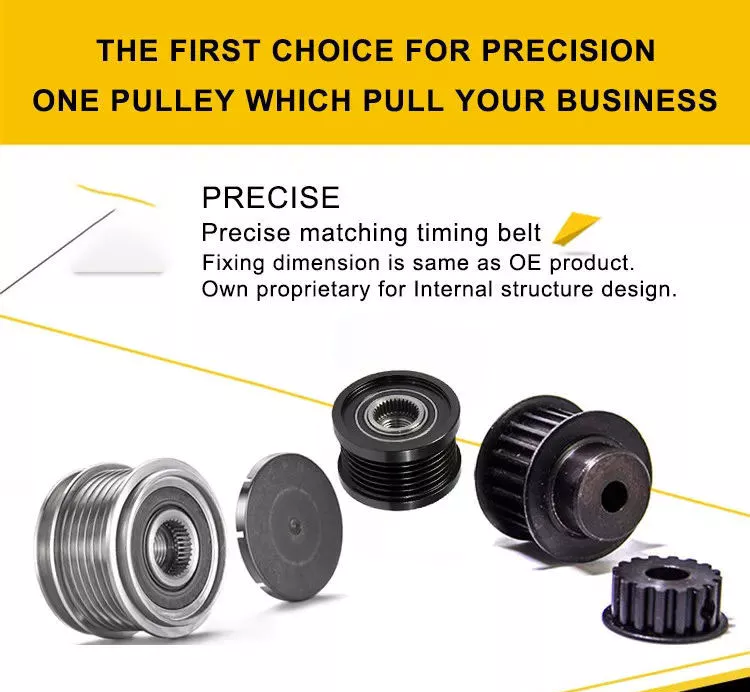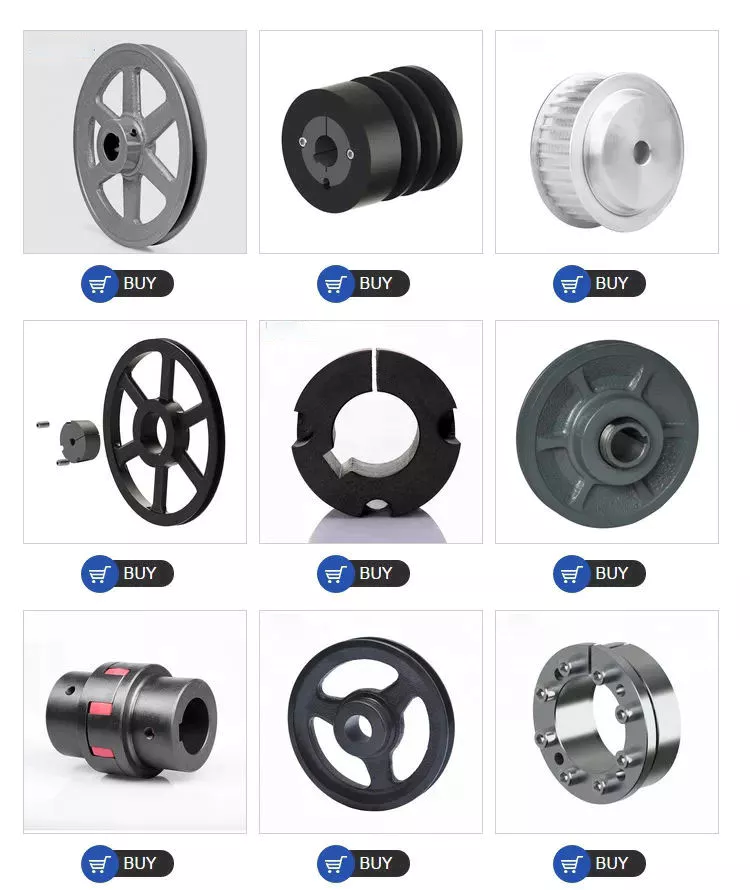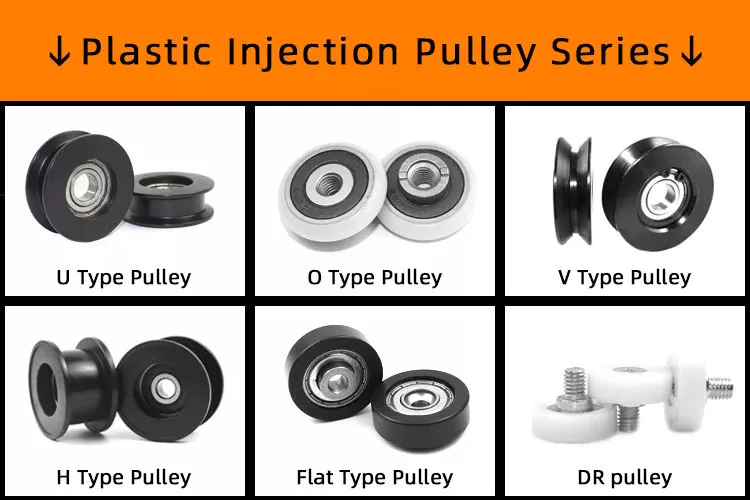وصف المنتج
CHINAMFG Machinery offers a wide range of high quality Timing Belt Pulleys and Toothed Bars / Timing Bars. Standard and non-standard pulleys according to drawings are available.
Types of material:
1. AlCuMgPb 6061 6082 Aluminum Timing Pulley
2. C45E 1045 S45C Carbon Steel Timing Pulley
3. GG25 HT250 Cast Iron Timing Pulley
4. SUS303 SUS304 AISI431 Stainless Steel Timing Pulley
5. Other material on demand, such as cooper, bronze and plastic
Types of surface treatment
1. Anodized surface -Aluminum Pulleys
2. Hard anodized surface — Aluminum Pulleys
3. Black Oxidized surface — Steel Pulleys
4. Zinc plated surface — Steel Pulleys
5. Chromate surface — Steel Pulleys; Cast Iron Pulleys
6. Nickel plated surface –Steel Pulleys; Cast Iron Pulleys
Types of teeth profile
| Teeth Profile | Pitch |
| HTD | 3M,5M,8M,14M,20M |
| AT | AT5,AT10,AT20 |
| T | T2.5,T5,T10 |
| MXL | 0.08″(2.032MM) |
| XL | 1/5″(5.08MM) |
| ل | 3/8″(9.525MM) |
| ح | 1/2″(12.7MM) |
| XH | 7/8″(22.225MM) |
| XXH | 1 1/4″(31.75MM) |
| STS STPD | S2M,S3M,S4.5M,S5M,S8M,S14M |
| RPP | RPP5M,RPP8M,RPP14M,RPP20M |
| PGGT | PGGT 2GT, 3GT and 5GT |
| PCGT | GT8M,GT14M |
Types of pitches and sizes
Imperial Inch Timing Belt Pulley,
1. Pilot Bore MXL571 for 6.35mm timing belt; teeth number from 16 to 72;
2. Pilot Bore XL037 for 9.53mm timing belt; teeth number from 10 to 72;
3. Pilot Bore, Taper Bore L050 for 12.7mm timing belt; teeth number from 10 to 120;
4. Pilot Bore, Taper Bore L075 for 19.05mm timing belt; teeth number from 10 to 120;
5. Pilot Bore, Taper Bore L100 for 25.4mm timing belt; teeth number from 10 to 120;
6. Pilot Bore, Taper Bore H075 for 19.05mm timing belt; teeth number from 14 to 50;
7. Pilot Bore, Taper Bore H100 for 25.4mm timing belt; teeth number from 14 to 156;
8. Pilot Bore, Taper Bore H150 for 38.1mm timing belt; teeth number from 14 to 156;
9. Pilot Bore, Taper Bore H200 for 50.8mm timing belt; teeth number from 14 to 156;
10. Pilot Bore, Taper Bore H300 for 76.2mm timing belt; teeth number from 14 to 156;
11. Taper Bore XH200 for 50.8mm timing belt; teeth number from 18 to 120;
12. Taper Bore XH300 for 76.2mm timing belt; teeth number from 18 to 120;
13. Taper Bore XH400 for 101.6mm timing belt; teeth number from 18 to 120;
Metric Timing Belt Pulley T and AT
1. Pilot Bore T2.5-16 for 6mm timing belt; teeth number from 12 to 60;
2. Pilot Bore T5-21 for 10mm timing belt; teeth number from 10 to 60;
3. Pilot Bore T5-27 for 16mm timing belt; teeth number from 10 to 60;
4. Pilot Bore T5-36 for 25mm timing belt; teeth number from 10 to 60;
5. Pilot Bore T10-31 for 16mm timing belt; teeth number from 12 to 60;
6. Pilot Bore T10-40 for 25mm timing belt; teeth number from 12 to 60;
7. Pilot Bore T10-47 for 32mm timing belt; teeth number from 18 to 60;
8. Pilot Bore T10-66 for 50mm timing belt; teeth number from 18 to 60;
9. Pilot Bore AT5-21 for 10mm timing belt; teeth number from 12 to 60;
10. Pilot Bore AT5-27 for 16mm timing belt; teeth number from 12 to 60;
11. Pilot Bore AT5-36 for 25mm timing belt; teeth number from 12 to 60;
12. Pilot Bore AT10-31 for 16mm timing belt; teeth number from 15 to 60;
13. Pilot Bore AT10-40 for 25mm timing belt; teeth number from 15 to 60;
14. Pilot Bore AT10-47 for 32mm timing belt; teeth number from 18 to 60;
15. Pilot Bore AT10-66 for 50mm timing belt; teeth number from 18 to 60;
Metric Timing Belt Pulley HTD3M, 5M, 8M, 14M
1. HTD3M-06; 3M-09; 3M-15; teeth number from 10 to 72;
2. HTD5M-09; 5M-15; 5M-25; teeth number from 12 to 72;
3. HTD8M-20; 8M-30; 8M-50; 8M-85 teeth number from 22 to 192;
4. HTD14M-40; 14M-55; 14M-85; 14M-115; 14M-170; teeth number from 28-216;
5. Taper Bore HTD5M-15; 8M-20; 8M-30; 8M-50; 8M-85; 14M-40; 14M-55; 14M-85;
14M-115; 14M-170
Metric Timing Belt Pulleys for Poly Chain GT2 Belts
1. PCGT8M-12; PCGT8M-21; PCGT8M-36; PCGT8M-62;
2. PCGT14M-20; PCGT14M-37; PCGT14M-68; PCGT14M-90; PCGT14M-125;
Power Grip CHINAMFG Tooth/ PGGT 2GT, 3GT and 5GT
1. 2GT-06, 2GT-09 for timing belt width 6mm and 9mm
2. 3GT-09, 3GT-15 for timing belt width 9mm and 15mm
3. 5GT-15, 5GT-25 for timing belt width 15mm and 25mm
OMEGA RPP HTD Timing Pulleys
1. RPP3M-06; 3M-09; 3M-15; teeth number from 10 to 72;
2. RPP5M-09; 5M-15; 5M-25; teeth number from 12 to 72;
3. RPP8M-20; 8M-30; 8M-50; 8M-85 teeth number from 22 to 192;
4. RPP14M-40; 14M-55; 14M-85; 14M-115; 14M-170; teeth number from 28-216;
5. Taper Bore RPP5M-15; 8M-20; 8M-30; 8M-50; 8M-85; 14M-40; 14M-55; 14M-85;
14M-115; 14M-170 .
Ubet Machinery is also competetive on these power transmission components.
/* March 10, 2571 17:59:20 */!function(){function s(e,r){var a,o={};try{e&&e.split(“,”).forEach(function(e,t){e&&(a=e.match(/(.*?):(.*)$/))&&1
| شهادة: | ايزو |
|---|---|
| أحجام البكرة: | Timing |
| عملية التصنيع: | Sawing |
| العينات: |
US$ 3/Piece
1 قطعة (الحد الأدنى للطلب) | Order Sample Normally sample order can be ready in 15 days
|
|---|
| التخصيص: |
متاح
| طلب مخصص |
|---|
.shipping-cost-tm .tm-status-off{background: none;padding:0;color: #1470cc}
|
Shipping Cost:
Estimated freight per unit. |
about shipping cost and estimated delivery time. |
|---|
| Payment Method: |
|
|---|---|
|
Initial Payment Full Payment |
| Currency: | US$ |
|---|
| Return&refunds: | You can apply for a refund up to 30 days after receipt of the products. |
|---|

How do multiple pulleys in a block and tackle system work together?
In a block and tackle system, multiple pulleys are used in combination to create a mechanical advantage, allowing for easier lifting of heavy loads. The pulleys in a block and tackle system work together in the following manner:
1. Load Distribution: The weight of the load to be lifted is distributed over multiple strands of rope or cable that pass through the pulleys. This distribution of weight helps in reducing the force required to lift the load.
2. Mechanical Advantage: The mechanical advantage in a block and tackle system is achieved by increasing the number of rope segments that support the load. Each additional pulley increases the number of rope segments, which in turn reduces the amount of force needed to lift the load. The mechanical advantage is equal to the number of segments of rope supporting the load.
3. Tension Distribution: As the load is lifted, the tension in the rope or cable changes. In a block and tackle system, the tension is distributed among the various segments of rope or cable connected to the pulleys. This distribution of tension ensures that the load is lifted evenly and prevents excessive stress on any single rope segment.
4. Rope Arrangement: The pulleys in a block and tackle system are arranged in two sets: the fixed pulleys and the movable pulleys. The fixed pulleys are attached to a fixed point, such as a beam or a ceiling, and do not move. The movable pulleys are attached to the load being lifted and can move freely. The arrangement of the pulleys determines the mechanical advantage and the direction of force required to lift the load.
By combining these principles, multiple pulleys in a block and tackle system allow for the effective lifting of heavy loads with reduced effort. The mechanical advantage provided by the pulleys makes it possible to lift loads that would otherwise be too heavy to lift manually. Block and tackle systems are commonly used in various applications, including construction, rigging, sailing, and theatrical setups.

ما هي أهمية محاذاة البكرة وشدها بشكل صحيح؟
إن محاذاة البكرة وشدها بشكل صحيح من العوامل الحاسمة في ضمان التشغيل الفعال والموثوق لأنظمة البكرات. فهي تلعب دورًا مهمًا في تعظيم نقل الطاقة وتقليل التآكل والتلف والحفاظ على الأداء العام وطول عمر النظام. وفيما يلي أهمية محاذاة البكرة وشدها بشكل صحيح:
1. كفاءة نقل الطاقة:
Proper pulley alignment and tensioning ensure optimal power transmission efficiency. When pulleys are misaligned or belts/chains are improperly tensioned, energy is wasted due to increased friction and slippage. This results in decreased power transfer and reduced system efficiency. By aligning the pulleys parallel to each other and applying the correct tension to the belts or chains, the system can achieve maximum power transmission, minimizing energy losses.
2. طول عمر الحزام/السلسلة:
يساهم ضبط محاذاة البكرة وشدها بشكل صحيح في إطالة عمر الأحزمة والسلاسل. يمكن أن يؤدي سوء المحاذاة والشد غير الكافي إلى تآكل غير متساوٍ وتمدد مفرط وفشل مبكر للأحزمة أو السلاسل. تعمل المحاذاة والشد المناسبان على توزيع الحمل بالتساوي عبر الأحزمة أو السلاسل، مما يقلل من الإجهاد ويطيل عمرها. يساعد هذا في تجنب التوقف غير المخطط له وتكاليف الصيانة والحاجة إلى استبدال الحزام/السلسلة بشكل متكرر.
3. تقليل الضوضاء والاهتزاز:
قد يؤدي عدم محاذاة البكرة وشدها بشكل صحيح إلى زيادة الضوضاء والاهتزاز في النظام. يمكن أن تتسبب البكرات غير المحاذية أو الأحزمة/السلاسل الفضفاضة في حدوث اهتزازات مفرطة، مما يؤدي إلى الضوضاء وتلف المعدات وعدم الراحة للمشغلين أو الموظفين القريبين. تساعد المحاذاة والشد المناسبين في تقليل الاهتزاز، مما يضمن تشغيلًا أكثر هدوءًا وبيئة عمل أكثر راحة.
4. موثوقية النظام وسلامته:
تساهم المحاذاة والشد المناسبان في تعزيز موثوقية أنظمة البكرات وسلامتها بشكل عام. يمكن أن تؤدي البكرات غير المحاذية أو الأحزمة/السلاسل الفضفاضة إلى أعطال أو أعطال أو حوادث غير متوقعة. يمكن أن يؤدي الشد الزائد أيضًا إلى إجهاد مفرط للمكونات وزيادة خطر فشل النظام. من خلال الحفاظ على المحاذاة والشد المناسبين، يعمل النظام ضمن معايير تصميمه، مما يقلل من احتمالية حدوث أعطال غير متوقعة ويضمن سلامة المشغلين والمعدات.
5. تحسين الأداء:
يعمل ضبط البكرات وشدها بشكل صحيح على تحسين الأداء العام للنظام. توفر الأحزمة أو السلاسل المشدودة بشكل صحيح قبضة وقوة جر أفضل، مما يسمح بحركة أكثر سلاسة ودقة للمكونات المحركة. يؤدي هذا إلى تحسين التحكم في السرعة وتقليل الانزلاق وتعزيز الدقة في التطبيقات مثل أنظمة النقل وأدوات الآلات ومحركات السيارات.
6. الصيانة وتوفير التكاليف:
يمكن أن يؤدي ضبط البكرات وشدها بشكل صحيح إلى توفير كبير في الصيانة والتكاليف. تتعرض البكرات المحاذية جيدًا والأحزمة أو السلاسل المشدودة بشكل صحيح لتآكل أقل وتتطلب تعديلات أقل. وهذا يقلل من تكرار مهام الصيانة، مثل استبدال الحزام/السلسلة وإعادة محاذاته وإعادة شدّه. بالإضافة إلى ذلك، من خلال تعظيم كفاءة نقل الطاقة وتقليل التآكل، تساعد المحاذاة والشد المناسبان في تقليل استهلاك الطاقة وخفض تكاليف التشغيل.
في الختام، يعد ضبط البكرات وشدها بشكل صحيح أمرًا بالغ الأهمية لتحقيق كفاءة نقل الطاقة المثلى، وإطالة عمر الأحزمة أو السلاسل، وتقليل الضوضاء والاهتزاز، وضمان موثوقية النظام وسلامته، وتحسين الأداء، وتحقيق الصيانة وتوفير التكاليف. من الضروري اتباع إرشادات الشركة المصنعة وإجراء عمليات تفتيش وتعديلات منتظمة للحفاظ على المحاذاة والشد المناسبين في أنظمة البكرات.

ما هي فوائد استخدام البكرات لتحقيق الميزة الميكانيكية؟
إن استخدام البكرات لتحقيق ميزة ميكانيكية يوفر العديد من المزايا في تطبيقات مختلفة. وفيما يلي المزايا الرئيسية:
1. زيادة قدرة الرفع: إحدى المزايا الأساسية لاستخدام البكرات لتحقيق ميزة ميكانيكية هي أنها تسمح برفع الأحمال الثقيلة بجهد أقل. من خلال توزيع الحمل على أجزاء متعددة من الحبل أو الحزام، تعمل البكرات على تقليل مقدار القوة المطلوبة لرفع الحمل. وهذا مفيد بشكل خاص في السيناريوهات التي تتضمن الرفع اليدوي أو الطاقة المحدودة.
2. سهولة التعامل مع الأحمال: تسهل البكرات التعامل مع الأحمال الثقيلة والتحكم فيها. تعمل الميزة الميكانيكية التي توفرها البكرات على تقليل القوة اللازمة لتحريك أو رفع الحمل، مما يسمح للمشغلين ببذل جهد أقل. وهذا يجعل المهام مثل رفع وخفض وتحديد موضع الأشياء الثقيلة أكثر قابلية للإدارة وأقل إرهاقًا جسديًا.
3. السلامة والوقاية من الإصابات: من خلال تقليل مقدار القوة المطلوبة لرفع الأحمال الثقيلة، تساهم البكرات في تحسين السلامة والوقاية من الإصابات. عندما يضطر العاملون إلى بذل جهد بدني أقل، يتم تقليل خطر الإجهاد والالتواء والإصابات الأخرى المرتبطة بالرفع بشكل كبير. تمكن البكرات من تحريك الحمولة بشكل أكثر سلاسة وتحكمًا، مما يقلل من خطر التحولات المفاجئة أو السقوط الذي قد يتسبب في وقوع حوادث.
4. تحديد موضع الحمل بدقة: توفر أنظمة البكرات تحكمًا دقيقًا في تحديد موضع الحمل. من خلال استخدام بكرات متعددة وضبط الشد في الحبل أو الحزام، يمكن للمشغلين تحقيق حركات رأسية وأفقية دقيقة للحمل. هذا المستوى من التحكم قيم بشكل خاص في التطبيقات التي تتطلب وضعًا دقيقًا للأشياء الثقيلة، مثل البناء والتصنيع ومناولة المواد.
5. التنوع والقدرة على التكيف: توفر البكرات التنوع والقدرة على التكيف في تطبيقات مختلفة. ويمكن تكوينها في ترتيبات ومجموعات مختلفة لتحقيق مزايا ميكانيكية محددة بناءً على متطلبات المهمة أو الحمل. ويمكن دمج البكرات بسهولة في الأنظمة الحالية أو دمجها في إعدادات مصممة خصيصًا، مما يجعلها قابلة للتكيف بدرجة كبيرة مع المواقف المختلفة.
6. نقل الطاقة بكفاءة: توفر البكرات نقلًا فعالًا للطاقة في الأنظمة الميكانيكية. فهي تمكن من نقل الحركة الدورانية والقوة من مكون إلى آخر مع الحد الأدنى من فقدان الطاقة. يسمح استخدام البكرات بتحسين نقل الطاقة، مما يضمن الاستخدام الفعال لمصادر الطاقة المتاحة.
7. الفعالية من حيث التكلفة: إن استخدام البكرات لتحقيق ميزة ميكانيكية يمكن أن يكون فعالاً من حيث التكلفة مقارنة بالطرق البديلة. فالبكرات عبارة عن أجهزة بسيطة واقتصادية نسبيًا ويمكن الحصول عليها بسهولة. وهي تتطلب الحد الأدنى من الصيانة ولها عمر تشغيلي طويل. بالإضافة إلى ذلك، يمكن غالبًا تصميم أنظمة البكرات وتنفيذها دون الحاجة إلى معدات معقدة ومكلفة.
وفي الختام، فإن استخدام البكرات لتحقيق ميزة ميكانيكية يوفر مزايا مثل زيادة قدرة الرفع، وسهولة التعامل مع الأحمال، والسلامة ومنع الإصابات، وتحديد موضع الحمل بدقة، والتنوع، ونقل الطاقة بكفاءة، والفعالية من حيث التكلفة. هذه المزايا تجعل البكرات أداة قيمة في مجموعة واسعة من الصناعات والتطبيقات.


محرر بواسطة CX
2024-01-23
